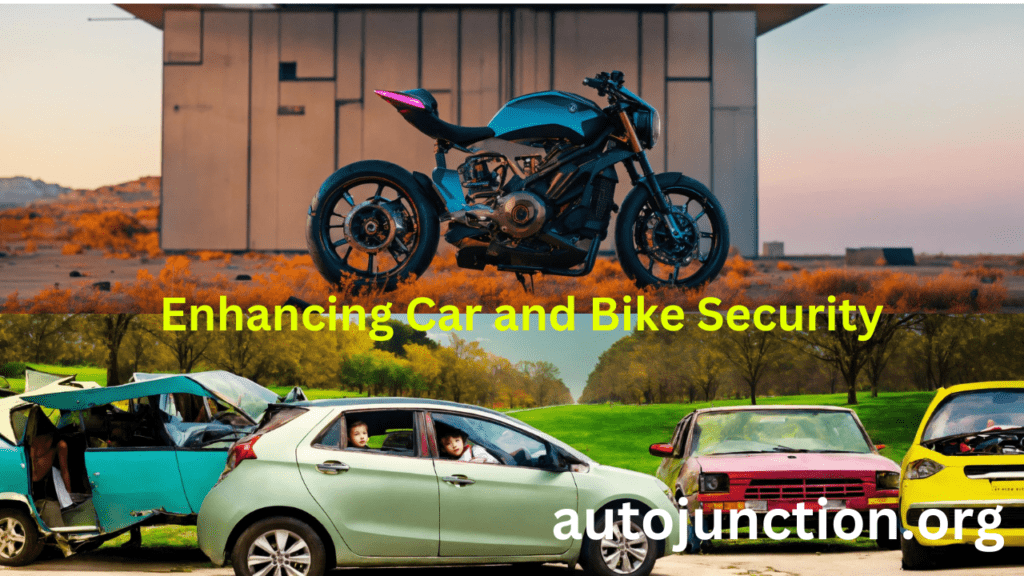In today's fast-paced world, safety on the road isn't just a luxury—it's a necessity. Whether you're cruising down the highway in a sleek sedan or zipping through city streets on a motorcycle, knowing that your vehicle is equipped with the latest safety features gives you peace of mind. But what exactly are these features? How are they revolutionizing the way we think about car and bike security? Buckle up, because we're about to take a deep dive into the cutting-edge technology that's making our roads safer than ever before.
The Evolution of Vehicle Safety
Safety in vehicles has come a long way since the days of basic seat belts and airbags. Back then, just having a seatbelt was considered a huge step forward. Fast forward to today, and we’ve got cars and bikes that practically think for themselves, thanks to advanced safety tech. From collision avoidance systems to automatic braking, modern vehicles are packed with features that not only protect you in case of an accident but also work to prevent accidents in the first place.

1. Collision Avoidance Systems: Your Car’s Guardian Angel
Imagine you’re driving on a rainy night, and suddenly, the car in front of you slams on its brakes. In the past, you’d have to rely solely on your reflexes to avoid a crash. But with today’s collision avoidance systems, your car is constantly scanning the road ahead, ready to warn you or even take action if it senses danger.
- How It Works: These systems use a combination of radar, cameras, and sensors to detect objects in your vehicle’s path. If a potential collision is detected, the system will alert you with visual and audio warnings. In some cases, it might even apply the brakes automatically.
- Real-World Example: The Subaru EyeSight Driver Assist Technology is a perfect example of this. It uses stereo cameras to monitor traffic movement, optimize cruise control, and warn you if you sway outside your lane.
2. Blind Spot Detection: Eyes in the Back of Your Head
Changing lanes can be a risky move, especially if there’s a vehicle lurking in your blind spot. This is where blind spot detection comes in handy. It’s like having an extra pair of eyes that watch your back when you’re making lane changes.
- How It Works: This feature uses sensors located on the sides of the car to detect vehicles in your blind spots. If a vehicle is detected, a warning light will flash on your side mirrors or dashboard.
- Real-World Example: The Honda Lane Watch feature displays live video from a camera on the passenger-side mirror when you signal right, giving you a clear view of what’s in your blind spot.
3. Adaptive Cruise Control: Smarter Cruising
Long drives can be tiring, but adaptive cruise control takes some of the stress off your shoulders. Unlike traditional cruise control, which maintains a constant speed, adaptive cruise control adjusts your speed to maintain a safe distance from the car ahead.
- How It Works: Using radar and cameras, this system monitors the traffic ahead and automatically slows down or speeds up your vehicle to keep a safe distance.
- Real-World Example: The Tesla Autopilot system offers a more advanced version of adaptive cruise control, where the car can even change lanes and take exits on the highway.
4. Automatic Emergency Braking: When Seconds Matter
In an emergency, every second counts. Automatic emergency braking systems are designed to act faster than human reflexes, reducing the risk of severe accidents.
- How It Works: If the system detects an imminent collision and you haven't responded in time, it will automatically apply the brakes to prevent or reduce the impact.
- Real-World Example: The Toyota Safety Sense P (TSS-P) suite includes an automatic emergency braking system that not only detects vehicles but also pedestrians, making it incredibly versatile.
5. Lane Keeping Assist: Stay in Your Lane
We’ve all had those moments when we drift out of our lane, whether due to distraction or drowsiness. Lane keeping assist is there to gently guide you back on track.
- How It Works: Cameras mounted on the car detect lane markings on the road. If you start to drift out of your lane without signaling, the system will either alert you or automatically steer you back into your lane.
- Real-World Example: The Mercedes-Benz Active Lane Keeping Assist not only warns you but can also make small steering adjustments to keep you safely in your lane.
6. Tire Pressure Monitoring Systems: Keeping You Rolling Safely
Underinflated tires can be a hidden danger, affecting your car's handling, fuel efficiency, and safety. Tire pressure monitoring systems (TPMS) keep an eye on your tires so you don’t have to.
- How It Works: Sensors in each tire measure the pressure and send the data to your car’s onboard computer. If the pressure drops below a safe level, you’ll receive an alert on your dashboard.
- Real-World Example: Many cars, including the Ford F-150, come with TPMS as a standard feature, ensuring you're always aware of your tire conditions.
7. Electronic Stability Control: Preventing Skids and Slides
Slippery roads can turn a routine drive into a dangerous situation. Electronic stability control (ESC) helps keep your vehicle stable, even in challenging conditions.
- How It Works: ESC monitors your vehicle's steering and direction. If it detects that the car is starting to skid, it automatically applies the brakes to individual wheels to help maintain control.
- Real-World Example: The BMW Dynamic Stability Control system is a prime example of ESC in action, adjusting the car’s power and braking to keep you on track.
8. Rearview Cameras and Parking Sensors: Navigating Tight Spaces
Parking can be a hassle, especially in crowded areas. Rearview cameras and parking sensors make it easier by giving you a clear view of what’s behind you and alerting you to obstacles.
- How It Works: A camera mounted on the back of your car sends a live video feed to your dashboard screen, showing you what’s behind you. Parking sensors, on the other hand, use ultrasonic waves to detect objects and warn you with beeps.
- Real-World Example: The Nissan Intelligent Around View Monitor takes it a step further by giving you a 360-degree bird’s-eye view of your car, making parking a breeze.
9. Anti-Lock Braking System (ABS): Stopping Safely
ABS is one of those features that we often take for granted, but it's been a game-changer in vehicle safety. It prevents your wheels from locking up during sudden braking, allowing you to maintain steering control.
- How It Works: ABS automatically modulates the brake pressure during an emergency stop to prevent the wheels from locking up, reducing the risk of skidding.
- Real-World Example: The Ford Escape comes with ABS as a standard feature, providing reliable braking performance in a variety of conditions.
10. Keyless Entry and Ignition: Convenience Meets Security
Gone are the days of fumbling for your keys in the dark. Keyless entry and ignition systems not only make life easier but also add an extra layer of Car and Bike Security to your vehicle.
- How It Works: With a key fob in your pocket or bag, you can unlock your car and start the engine with just the push of a button. The car's computer system communicates with the key fob, ensuring that only the right key can unlock and start the car.
- Real-World Example: The Audi Advanced Key system lets you unlock and start your car without even taking the key fob out of your pocket.
11. Advanced Airbag Systems: More Than Just a Cushion
Airbags have been around for a while, but today's systems are far more advanced. Modern airbags are designed to protect not just the driver and front passenger, but also rear passengers and even pedestrians in some cases.
- How It Works: In the event of a collision, sensors in the car detect the impact and deploy the airbags. Advanced systems can adjust the deployment force based on the severity of the crash and the position of the occupants.
- Real-World Example: The Volvo XC90 comes with an innovative airbag system that includes a pedestrian airbag, which deploys from the hood in the event of a collision with a pedestrian.
12. Vehicle-to-Vehicle Communication: Cars That Talk to Each Other
One of the most exciting developments in vehicle safety is Vehicle-to-Vehicle (V2V) communication. Imagine if cars could talk to each other to avoid accidents—that’s exactly what this technology aims to achieve.
- How It Works: V2V communication allows cars to share information about their speed, position, and direction with nearby vehicles. This data can be used to alert drivers to potential hazards, such as a car suddenly stopping up ahead.
- Real-World Example: Cadillac’s CTS sedan is one of the first vehicles to feature V2V communication, enabling it to exchange information with other vehicles equipped with the same technology.
13. Motorcycle Safety Features: Keeping Bikers Safe
Motorcycles have always been at a higher risk on the road, but new safety features are helping to level the playing field. From anti-lock brakes to stability control, these technologies are making riding safer than ever.
- Anti-Lock Brakes for Bikes: Similar to cars, ABS on motorcycles prevents the wheels from locking up during hard braking, reducing the risk of a skid.
- Traction Control: This feature helps maintain grip on slippery surfaces, preventing the bike from sliding out from under you.
- Real-World Example: The BMW R 1250 GS comes with both ABS and traction control, offering riders an extra layer of safety.
14. Smart Helmets: A New Era of Bike Safety
Helmets are essential for motorcycle safety, but smart helmets take them to a whole new level. These high-tech helmets come equipped with features like built-in GPS, rearview cameras, and even voice control, providing riders with more information and protection on the road.
- How It Works: Smart helmets are designed with integrated electronics that connect to your smartphone via Bluetooth. They can display navigation directions on a heads-up display, monitor blind spots with rearview cameras, and allow you to control music or answer calls without taking your hands off the handlebars.
- Real-World Example: The Sena Momentum Pro is a smart helmet that includes a 360-degree camera, built-in communication system, and voice commands, making it one of the most advanced helmets on the market.
15. Anti-Theft Systems: Protecting Your Ride
In an age where car theft is still a concern, anti-theft systems have become more sophisticated. Modern vehicles are equipped with a variety of features designed to deter thieves and protect your investment.
- How It Works: Anti-theft systems can include everything from immobilizers that prevent the engine from starting without the correct key, to GPS tracking systems that allow you to locate your vehicle if it’s stolen. Some vehicles also feature audible alarms, motion sensors, and even remote disabling capabilities.
- Real-World Example: The LoJack Stolen Vehicle Recovery System is a popular option, using GPS and radio frequency technology to help law enforcement locate and recover stolen vehicles.
16. Driver Attention Monitoring: Keeping You Alert
Long drives and late-night journeys can lead to driver fatigue, which is a major cause of accidents. Driver attention monitoring systems are designed to keep you alert by detecting signs of drowsiness or distraction.
- How It Works: These systems use cameras and sensors to monitor your driving behavior, such as steering patterns and the time spent on the road. If the system detects signs of fatigue, it will alert you with audio or visual cues, and some systems may even suggest taking a break.
- Real-World Example: The Mercedes-Benz Attention Assist system is a leader in this field, analyzing over 70 parameters to determine if you're getting tired and warning you before it’s too late.
17. Night Vision Assist: Seeing Beyond Your Headlights
Driving at night can be challenging, especially on poorly lit roads. Night vision assist technology helps you see further than your headlights allow, reducing the risk of accidents in low-visibility conditions.
- How It Works: Night vision systems use infrared cameras to detect heat from objects ahead, such as pedestrians or animals. The system then displays this information on a screen in your dashboard, allowing you to see beyond your headlights.
- Real-World Example: The Audi A8 offers an advanced night vision assist system that highlights potential hazards on the road, giving you extra time to react.
18. Cross-Traffic Alert: Watching Your Back
Backing out of a parking spot or driveway can be tricky, especially when visibility is limited. Cross-traffic alert systems make this task safer by warning you of approaching vehicles or pedestrians from the side.
- How It Works: Using sensors located at the rear of the vehicle, the system detects moving objects from either side and alerts you with visual and audio warnings. Some systems can even apply the brakes automatically if a collision is imminent.
- Real-World Example: The Ford Edge’s cross-traffic alert system is one of the most effective, providing alerts and even emergency braking when necessary.
19. Vehicle Security Apps: Control at Your Fingertips
With the rise of smartphones, vehicle Car and Bike Security has gone mobile. Today, you can monitor and control various aspects of your car’s security right from your phone.
- How It Works: Vehicle Car and Bike Security apps connect to your car’s onboard system, allowing you to lock or unlock doors, start the engine, and even track the car’s location—all from your smartphone. Some apps also send alerts if your vehicle is tampered with or moved without your permission.
- Real-World Example: Tesla’s mobile app is a prime example, offering features like remote start, location tracking, and even the ability to summon your car from a parking spot.
20. Advanced Lighting Systems: Illuminating the Road Ahead
Modern vehicles are equipped with lighting systems that do much more than just light the way. From adaptive headlights that turn with your steering wheel to LED lights that improve visibility, these systems are enhancing safety on the road.
- How It Works: Adaptive headlights use sensors to detect the direction of your steering and adjust the angle of the headlights accordingly, improving visibility on curves. LED lights, on the other hand, offer brighter and more efficient lighting compared to traditional halogen bulbs.
- Real-World Example: The BMW Adaptive LED Headlights are a top-tier example, providing enhanced visibility on winding roads and in adverse weather conditions.
21. Pedestrian Detection: Protecting the Most Vulnerable
Pedestrian detection systems are designed to protect those who are most vulnerable on the road. By detecting pedestrians and cyclists in your vehicle’s path, these systems help prevent accidents in urban environments.
- How It Works: Pedestrian detection uses cameras and sensors to identify people and bikes on or near the roadway. If the system detects a potential collision, it will warn you and, if necessary, apply the brakes automatically.
- Real-World Example: Volvo’s City Safety system includes pedestrian and cyclist detection, offering an extra layer of protection in busy urban settings.
Conclusion: The Road Ahead for Vehicle Safety
The advancements in vehicle safety technology are nothing short of remarkable. From collision avoidance systems that act as an extra set of eyes on the road to smart helmets that protect motorcycle riders in new ways, these innovations are making our roads safer than ever. As we look to the future, the integration of even more advanced features, such as Vehicle-to-Vehicle communication and autonomous driving technologies, promises to further reduce accidents and save lives.
However, while these technologies are impressive, it's essential to remember that no system can replace responsible driving. The best safety feature is still a cautious and attentive driver. So, as you enjoy the benefits of these advanced safety systems, always keep in mind that your actions behind the wheel play a critical role in keeping you and others safe.
FAQs: Your Questions Answered
1. What is the most important safety feature in a car?
While all safety features are crucial, automatic emergency braking (AEB) is often considered one of the most critical because it can prevent accidents before they happen by reacting faster than a human driver.
2. Can blind spot detection be added to an older vehicle?
Yes, blind spot detection can be added to older vehicles through aftermarket systems. These typically involve installing sensors and a display system that alerts you to vehicles in your blind spot.
3. How do adaptive headlights improve safety?
Adaptive headlights improve safety by adjusting the angle of the headlights based on the direction of the steering wheel. This provides better illumination on curves and reduces the chances of accidents on winding roads.
4. Are smart helmets worth the investment for motorcyclists?
Smart helmets are a valuable investment for motorcyclists who want enhanced safety features such as built-in GPS, rearview cameras, and voice controls. They offer additional protection and convenience, especially for long rides.
Discover more from Autojunction
Subscribe to get the latest posts sent to your email.





